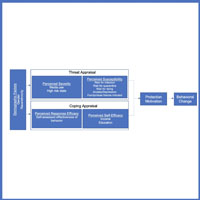Age differences in the relationship between threatening and coping mechanisms and preventive behaviors in the time of COVID-19 in the United States: Protection Motivation Theory

Submitted: August 8, 2020
Accepted: November 27, 2020
Published: January 14, 2021
Accepted: November 27, 2020
Abstract Views: 5662
PDF: 976
HTML: 29
HTML: 29
Publisher's note
All claims expressed in this article are solely those of the authors and do not necessarily represent those of their affiliated organizations, or those of the publisher, the editors and the reviewers. Any product that may be evaluated in this article or claim that may be made by its manufacturer is not guaranteed or endorsed by the publisher.
All claims expressed in this article are solely those of the authors and do not necessarily represent those of their affiliated organizations, or those of the publisher, the editors and the reviewers. Any product that may be evaluated in this article or claim that may be made by its manufacturer is not guaranteed or endorsed by the publisher.
Similar Articles
- Marta Vecchiato, Chiara Sacchi, Alessandra Simonelli, Nicola Purgato, Evaluating the efficacy of psychodynamic treatment on a single case of autism. A qualitative research , Research in Psychotherapy: Psychopathology, Process and Outcome: Vol. 19 No. 1 (2016): Special issue on Qualitative and Quantitative Research in Child and Adolescent Psychotherapy: part 2
- Elizabeth Li, Chloe Campbell, Nick Midgley, Patrick Luyten, Epistemic trust: a comprehensive review of empirical insights and implications for developmental psychopathology , Research in Psychotherapy: Psychopathology, Process and Outcome: Vol. 26 No. 3 (2023)
- Osmano Oasi, Laura Buonarrivo, Alberto Codazzi, Margherita Passalacqua, Gio Matteo Risso Ricci, Francesca Straccamore, Roberto Bezzi, Assessing personality change with Blatt's anaclitic and introjective configurations and Shedler-Westen Assessment Procedure profiles: two case studies in psychodynamic treatment , Research in Psychotherapy: Psychopathology, Process and Outcome: Vol. 20 No. 1 (2017)
- Gianluca Cruciani, Marianna Liotti, Vittorio Lingiardi, Motivations to become psychotherapists: beyond the concept of the wounded healer , Research in Psychotherapy: Psychopathology, Process and Outcome: Vol. 27 No. 2 (2024)
- Raffaella Perrella, Nadia Del Villano, Giorgio Caviglia, Referential activity, dissociation, psychopathology and psychotherapy , Research in Psychotherapy: Psychopathology, Process and Outcome: Vol. 19 No. 2 (2016)
- Jordan Bate, Angelica Tsakas, Facilitative interpersonal skills are relevant in child therapy too, so why don’t we measure them? , Research in Psychotherapy: Psychopathology, Process and Outcome: Vol. 25 No. 1 (2022)
- Marianna Liotti, Alice Fiorini Bincoletto, Fabiola Bizzi, Marta Tironi, Simone Charpentier Mora, Donatella Cavanna, Guido Giovanardi, Elliot Jurist, Anna Maria Speranza, Vittorio Lingiardi, Annalisa Tanzilli, The catcher in the mind: validation of the brief-mentalized affectivity scale for adolescents in the Italian population , Research in Psychotherapy: Psychopathology, Process and Outcome: Vol. 26 No. 3 (2023)
- Alessandro Talia, Anna Georg, Björn Siepe, Salvatore Gullo, Madeleine Miller-Bottome, Jana Volkert, Corinne Neukel, Michael Kaess, Felix Bempohl, Sabine C. Herpertz, Svenja Taubner, An exploratory study on how attachment classifications manifest in group psychotherapy , Research in Psychotherapy: Psychopathology, Process and Outcome: Vol. 25 No. 3 (2022): SPECIAL ISSUE: "Group psychotherapy: between settled benchmarks and new horizons"
- Gabriel Gònzalez, Vanetza E. Quezada, A brief cognitive-behavioral intervention for stress, anxiety and depressive symptoms in dental students , Research in Psychotherapy: Psychopathology, Process and Outcome: Vol. 19 No. 1 (2016): Special issue on Qualitative and Quantitative Research in Child and Adolescent Psychotherapy: part 2
- Zelda Gillian Knight, Psychotherapy with two late adulthood children of the colonies , Research in Psychotherapy: Psychopathology, Process and Outcome: Vol. 20 No. 3 (2017)
<< < 1 2 3 4 5 6 7 8 9 10 > >>
You may also start an advanced similarity search for this article.

 https://doi.org/10.4081/ripppo.2020.485
https://doi.org/10.4081/ripppo.2020.485





